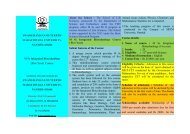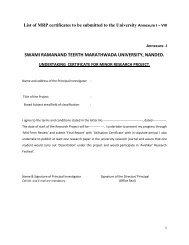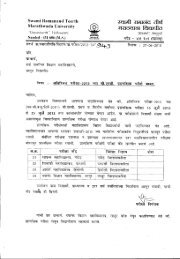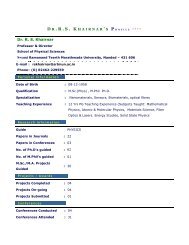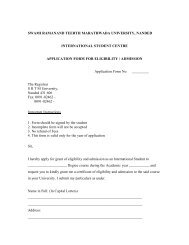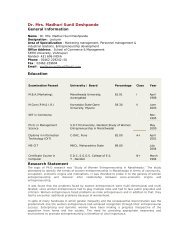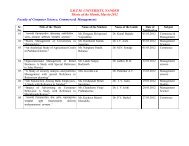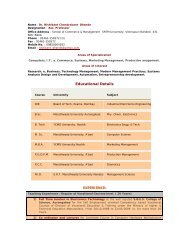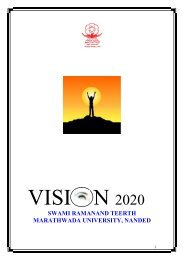Botany B.Sc I - The Swami Ramanand Teerth Marathwada University
Botany B.Sc I - The Swami Ramanand Teerth Marathwada University
Botany B.Sc I - The Swami Ramanand Teerth Marathwada University
Create successful ePaper yourself
Turn your PDF publications into a flip-book with our unique Google optimized e-Paper software.
SWAMI RAMANANAD TEERTH MARATHWADA UNIVERSITY, NANDED<br />
B.<strong>Sc</strong>. First Year<br />
Semester - I<br />
(MCQ Pattern)<br />
BOTANY<br />
<strong>The</strong>ory Paper-I: Diversity of Microbes<br />
(Viruses, Bacteria, Fungi and Lichens)<br />
Periods – 45 Maximum Marks – 50<br />
________________________________________________________________________<br />
UNIT – I: VIRUSES (10 periods)<br />
1. General characters of viruses<br />
2. Classification of viruses based on host.<br />
3. Ultra structure of TMV<br />
4. Symptoms of viral diseases of plants<br />
5. Yellow vein mosaic of Bhendi<br />
6. Bean mosaic<br />
7. Transmission of viruses<br />
8. Economic importance of viruses<br />
UNIT – II: BACTERIA (10 periods)<br />
1. General characters of bacteria<br />
2. Ultra structure of bacterial cell<br />
3. Asexual reproduction (By binary fission and endospore formation) in bacteria<br />
4. Sexual reproduction (By conjugation) in bacteria<br />
5. Salient features of cyanobacteria<br />
6. Systematic position, habitat, distribution, structure and reproduction in Nostoc<br />
7. Role of bacteria and cyanobacteria in agriculture<br />
8. Archaebacteria – Introduction and Forms<br />
UNIT – III: FUNGI (12 periods)<br />
1. General characters of Fungi<br />
2. Classification of Fungi (as per Alexopolous and Mims,1979)<br />
3. Systematic position, occurrence, structure of mycelium, asexual reproduction,<br />
sexual reproduction and graphic life cycle of following fungal types<br />
i. Mastigomycotina – Albugo<br />
ii. Ascomycotina – Eurotium<br />
UNIT – IV: FUNGI AND LICHENS (13 periods)<br />
1. Systematic position, occurrence, structure of mycelium, asexual reproduction,<br />
sexual reproduction and graphic life cycle of following fungal types<br />
iii. Basidiomycotina – Agaricus<br />
iv. Deuteromycotina – Cercospora (Tikka disease of groundnut)<br />
2. Role of fungi in fermentation industries (Bakery and Brewery)<br />
3. General characters of lichens<br />
4. Types of lichens<br />
5. Economic importance of lichens



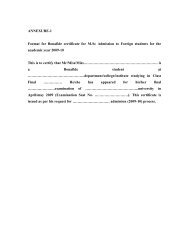

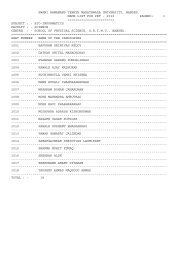
![Lokeh jkekuan rhFkZ ejkBokMk fo|kihB] ukan sM - - The Swami ...](https://img.yumpu.com/26553812/1/190x245/lokeh-jkekuan-rhfkz-ejkbokmk-fo-kihb-ukan-sm-the-swami-.jpg?quality=85)
